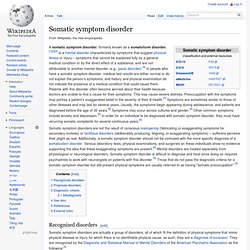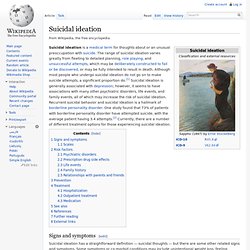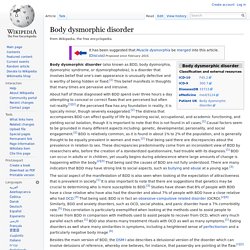

Somatoform disorder. A somatic symptom disorder, formerly known as a somatoform disorder,[1][2][3] is a mental disorder characterized by symptoms that suggest physical illness or injury – symptoms that cannot be explained fully by a general medical condition or by the direct effect of a substance, and are not attributable to another mental disorder (e.g., panic disorder).[4] In people who have a somatic symptom disorder, medical test results are either normal or do not explain the person's symptoms, and history and physical examination do not indicate the presence of a medical condition that could cause them.

Patients with this disorder often become worried about their health because doctors are unable to find a cause for their symptoms. This may cause severe distress. Preoccupation with the symptoms may portray a patient's exaggerated belief in the severity of their ill-health.[5] Symptoms are sometimes similar to those of other illnesses and may last for several years. Anorexia nervosa. Anorexia nervosa is often coupled with a distorted self image[3][4] which may be maintained by various cognitive biases[5] that alter how the affected individual evaluates and thinks about their body, food, and eating.[6] People with anorexia nervosa often view themselves as overweight or "big" even when they are already underweight.[7] Anorexia nervosa most often has its onset in adolescence and is more prevalent among adolescent females than adolescent males.[8] While the majority of people with anorexia nervosa continue to feel hunger, they deny themselves all but very small quantities of food.[6] The average caloric intake of individuals with anorexia nervosa varies drastically depending both on whether the individual engages in binging and/or purging behavior, and if the individual has engaged in that behavior in the day in question.[9] Extreme cases of complete self-starvation are known.

Signs and symptoms[edit] Symptoms of a person with anorexia nervosa may include: Suicidal ideation. Suicidal ideation is a medical term for thoughts about or an unusual preoccupation with suicide.

The range of suicidal ideation varies greatly from fleeting to detailed planning, role playing, and unsuccessful attempts, which may be deliberately constructed to fail or be discovered, or may be fully intended to result in death. Although most people who undergo suicidal ideation do not go on to make suicide attempts, a significant proportion do.[1] Suicidal ideation is generally associated with depression; however, it seems to have associations with many other psychiatric disorders, life events, and family events, all of which may increase the risk of suicidal ideation. Recurrent suicidal behavior and suicidal ideation is a hallmark of borderline personality disorder.
Signs and symptoms[edit] Suicidal ideation has a straightforward definition — suicidal thoughts — but there are some other related signs and symptoms. Body dysmorphic disorder. Body dysmorphic disorder (also known as BDD, body dysmorphia, dysmorphic syndrome, or dysmorphophobia), is a disorder that involves belief that one's own appearance is unusually defective and is worthy of being hidden or fixed.[1] This belief manifests in thoughts that many times are pervasive and intrusive.

Besides the main version of BDD, the DSM-I also describes a delusional version of the disorder which can involve delusions of reference, whereby one believes, for instance, that passersby are pointing at the flaw.[1][2] §Symptoms[edit] §Diagnosis[edit] §Treatment[edit] Cognitive behavior therapy (CBT) is thought to be an effective treatment for BDD.[13][14] A meta-analysis found CBT more effective than medication after 16 weeks of treatment.[15] CBT may improve connections between the orbitofrontal cortex and the amygdala.[16] §History[edit] §Research[edit] §See also[edit] §References[edit] ^ Jump up to: a b c d e f g h i j k l m n Cororve, Michelle; Gleaves, David (August 2001).